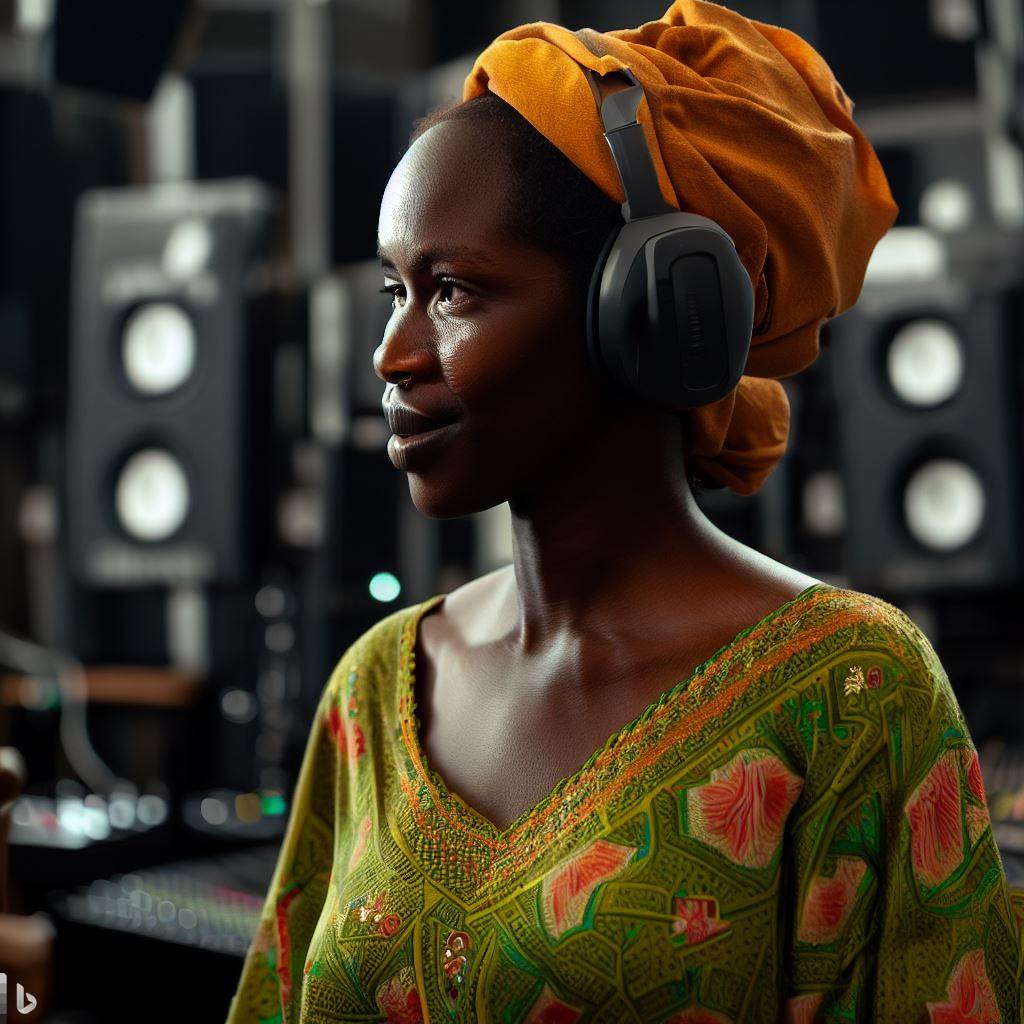Introduction
In Nigeria, the cinema industry has experienced significant growth in recent years, with a surge in local productions. In this blog section, we will explore how Nigeria Foley Artists are redefining sound in cinema.
Foley Artists play a vital role in cinema by creating and enhancing sound effects. They add a layer of realism and immersion to movies, making them more engaging for the audience.
Definition and Importance of Foley Artists
Foley Artists are sound specialists who create and record additional sounds to enhance the audio of a film.
They use everyday objects and various techniques to produce realistic sound effects, such as footsteps, door slams, or even the rustling of clothes.
Their work is crucial to creating an immersive cinematic experience.
Overview of the Nigerian Cinema Industry and its Growth
Nigeria’s cinema industry, known as Nollywood, has witnessed remarkable growth over the years. It has become the second-largest film industry globally, producing a vast number of films each year.
This growth has led to increased demand for high-quality sound production, prompting the emergence of talented Foley Artists.
Thesis Statement: Nigeria’s Foley Artists are revolutionizing sound in cinema
Nigeria’s Foley Artists are pushing the boundaries of sound design in cinema, bringing innovation and creativity to the industry.
Through their skills, they are redefining sound and creating a distinctive audio experience for Nigerian movies.
By exploring their techniques and achievements, we will delve into the impact they have on the overall cinematic experience.
In the following sections, we will explore the techniques used by Nigerian Foley Artists, their contributions to Nigerian films, and the challenges they face in their pursuit of excellence.
Through this exploration, we will gain a deeper understanding of their invaluable role in redefining sound in Nigerian cinema.
So, let’s dive into the world of Nigeria’s Foley Artists and discover the magic they bring to the silver screen.
Explaining Foley Art
How Nigeria Foley Artists are Redefining Sound in Cinema is a testament to their remarkable creativity and ingenuity, elevating the auditory experience of films.
Definition and evolution of Foley Art in the film industry
- Foley Art is the process of creating and recording sound effects in post-production for movies.
- It was named after Jack Foley, a pioneering sound effects artist in the early days of cinema.
- Over the years, Foley Art has evolved into a specialized craft, with dedicated Foley Artists and studios.
- Advancements in technology have allowed for more precise and realistic sound effects.
Role of Foley Artists in creating realistic sound effects
- Foley Artists use various props and equipment to reproduce everyday sounds on-screen.
- They use footsteps, clothing rustles, and object movements to enhance the realism of a scene.
- By syncing their actions with the visuals, Foley Artists bring the sound effects to life.
- Their attention to detail ensures that each sound matches the intensity and timing of the action.
Importance of Foley Art in enhancing the cinematic experience
- Foley Art plays a crucial role in immersing the audience in the movie’s world.
- Realistic sound effects can make the viewers feel more connected to the characters and their surroundings.
- By adding depth and dimension to the audio, Foley Art enhances the overall storytelling.
- It complements the visuals and dialogue, creating a more engaging and captivating cinematic experience.
- Without Foley Art, movies would lack the richness and realism that sound brings to the storytelling.
Read: Nigeria’s Animation Industry: Past, Present, Future
Rise of Nigerian Foley Artists
Exploring How Nigeria Foley Artists are Redefining Sound in Cinema unveils a fascinating world of behind-the-scenes artistry that adds depth to on-screen storytelling.
Overview of the Nigerian film industry (Nollywood)
- Nollywood is the second largest film industry in the world, producing thousands of films annually.
- Known for its low-budget productions, Nollywood has gained international recognition for its unique storytelling.
- The industry has grown rapidly, creating employment opportunities and contributing significantly to Nigeria’s economy.
Growth and development of Foley Art in Nigeria
- Foley Art is the art of creating and recording sound effects for films.
- In the early years of Nollywood, sound was mostly neglected, but as the industry matured, the importance of sound became recognized.
- Nigerian filmmakers started relying on Foley Artists to enhance the audio experience of their films.
- Initially, Nigerian Foley Artists faced challenges due to the lack of proper equipment and resources.
- However, with advancements in technology and increased investment in the film industry, Foley Art in Nigeria began to flourish.
Factors contributing to the rise of Nigerian Foley Artists
- Increasing demand for high-quality films in Nigeria led to the need for professional sound design.
- Nigerian Foley Artists developed a deep understanding of the culture and nuances of their target audience.
- They were able to accurately create sounds that resonated with Nigerian viewers, enhancing their cinematic experience.
- The rise of social media platforms allowed Foley Artists to showcase their work to a wider audience.
- Recognition and appreciation from local and international film festivals and award ceremonies boosted the profile of Nigerian Foley Artists.
- This recognition attracted more investment into Foley Art, leading to better training and infrastructure for aspiring Nigerian Foley Artists.
In a nutshell, the rise of Nigerian Foley Artists is closely tied to the growth of the Nigerian film industry and the increasing demand for high-quality films.
As Nollywood evolved, the importance of sound design became evident, leading to the rise of Foley Art in Nigeria.
Factors such as a deep understanding of the target audience, advancements in technology, and recognition from film festivals played a significant role in the development of Nigerian Foley Artists.
With ongoing support and investment, these artists continue to redefine sound in Nigerian cinema, providing audiences with an immersive cinematic experience.
Read: The Role of Public Relations Specialists in Nigeria Today
The Creative Process of Nigerian Foley Artists
The article delves into How Nigeria Foley Artists are Redefining Sound in Cinema, shedding light on their pivotal role in shaping the sonic landscapes of movies.
Steps involved in creating Foley sound effects
- Breaking down the film: Nigerian Foley artists begin by watching the film carefully to identify sounds that need to be created or enhanced.
- Gathering props: They collect various objects that are needed to create the desired sound effects, such as different types of footwear, utensils, or even unconventional objects.
- Preparing the recording space: Foley artists set up a recording area, which could be a specially designed studio or any other quiet space, where they can effectively capture the desired sounds.
- Performing the sounds: With the film playing, Foley artists meticulously perform the required sounds using the gathered props. They carefully synchronize their actions with the visuals on the screen.
- Capturing the sounds: Using specialized microphones and recording equipment, the Foley artists record the sounds they are creating in real-time.
This ensures that the sounds are accurately captured and can later be synchronized with the film. - Editing and mixing: After recording the sounds, the Nigerian Foley artists go through a meticulous editing process, where they select the best takes and sync them with the film.
They also add other audio elements and mix everything to ensure a seamless integration of sound with the visuals.
Tools and techniques used by Nigerian Foley Artists
- Props: Nigerian Foley artists use a wide variety of props to recreate sounds, including different types of shoes, clothing, household items, and even natural elements like soil or water.
- Microphones: They use high-quality microphones to capture the sounds accurately and with utmost clarity. Different microphone techniques are employed depending on the scene and desired effect.
- Foley pits: Specially designed pits or platforms are used to create sounds like footsteps or movements on different surfaces.
These pits have various materials like sand, gravel, or wooden planks that can be manipulated to produce specific sounds. - Foley props: Foley artists use specially designed props that mimic specific sounds. For example, they may use coconut shells as the sound of a horse galloping or cellophane paper to imitate fire crackling.
- Digital audio workstations (DAWs): These software tools allow Nigerian Foley artists to edit and manipulate the recorded sounds, synchronize them with visuals, and mix them with other audio elements.
Notable projects showcasing Nigerian Foley Artistry
- “The Figurine”: This Nigerian movie, directed by Kunle Afolayan, gained international acclaim for its exceptional sound design, including the immersive Foley sound effects.
- “October 1”: Another film by Kunle Afolayan, it showcases the attention to detail in Foley sound effects, helping to enhance the overall cinematic experience.
- “King of Boys”: This Nigerian crime thriller directed by Kemi Adetiba features outstanding Foley work, creating a realistic and captivating soundscape.
- “The CEO”: Directed by Kunle Afolayan, this film explores the corporate world and incorporates intricate Foley sound effects that add depth and realism to the storytelling.
- “Oloture”: This Nigerian crime drama, directed by Kenneth Gyang, effectively utilizes Foley sound effects to immerse the audience in the gritty world it portrays.
In review, Nigerian Foley artists follow a meticulous creative process that involves breaking down the film, gathering props, performing and capturing sounds, and then editing and mixing them.
They utilize various tools and techniques, such as props, microphones, Foley pits, and digital audio workstations.
Their exceptional skills and craftsmanship can be witnessed in notable projects like “The Figurine,” “October 1,” “King of Boys,” “The CEO,” and “Oloture.”
Through their artistry, Nigerian Foley artists continue to redefine sound in cinema, making Nigerian films more immersive and captivating.
Read: Building a Foley Studio in Nigeria: Costs and Considerations

How Nigeria’s Foley Artists are Redefining Sound in Cinema
By pushing boundaries and embracing innovation, How Nigeria’s Foley Artists are Redefining Sound in Cinema have garnered international recognition for their contributions to the cinematic universe.
Impact of Nigerian Foley Artists
Sound design and Foley artistry play an integral role in the overall cinematic experience.
Nigerian Foley artists have significantly impacted the Nigerian film industry, enhancing storytelling, and elevating the quality and authenticity of Nigerian films.
This section explores the impact they have made and the recognition they have received.
Enhancing storytelling and audience engagement
- Foley artists bring scenes to life by adding sound effects that enhance the emotional impact of the story.
- These artists create footstep sounds, ambient noises, and environmental soundscapes that immerse the audience in the film.
- Through Foley artistry, Nigerian filmmakers can effectively convey emotion, setting, and atmosphere.
- The attention to detail in Foley work helps audiences connect more deeply with the characters and their experiences.
- By accentuating the smallest sounds, Foley artists create a more engaging and immersive cinematic experience.
Elevating the quality and authenticity of Nigerian films
- Nigerian Foley artists ensure that films have high-quality sound design, on par with international standards.
- Their work adds a professional touch to Nigerian films, making them more competitive in the global market.
- Foley artists pay attention to cultural nuances and strive to create authentic sounds that resonate with local audiences.
- With their creativity and technical skills, they elevate the overall production value of Nigerian films.
- Their contribution enhances the viewing experience, enabling audiences to appreciate Nigerian cinema on a new level.
Recognition and awards received by Nigerian Foley Artists
- Nigerian Foley artists have started getting recognition and accolades both locally and internationally.
- They have been nominated and won various awards in the field of sound design, including Best Foley Artist.
- International film festivals have showcased the work of Nigerian Foley artists, celebrating their talent.
- This recognition not only highlights their skill but also brings attention to the Nigerian film industry as a whole.
- Nigerian Foley artists are becoming ambassadors for the country’s creative talent, gaining exposure worldwide.
Basically, Nigerian Foley artists have had a profound impact on the Nigerian film industry.
They enhance storytelling, engage audiences, elevate film quality, and receive recognition and awards for their exceptional work.
Their contributions are redefining sound in Nigerian cinema and putting the country’s creative talent on the global map.
Read: The Evolution of Foley Artistry in Nigerian Film Industry
Challenges and Future of Nigerian Foley Artists
From mimicking subtle footsteps to capturing grandiose environmental sounds, how Nigeria Foley Artists are Redefining Sound in Cinema are revolutionizing audiovisual experiences.
Limited resources and lack of recognition in the industry
- Nigerian Foley artists often face challenges due to limited resources available for their craft.
- The lack of proper equipment and facilities restricts their ability to produce high-quality sound effects.
- Additionally, the industry in Nigeria has historically undervalued the importance of sound design and Foley artistry.
- Foley artists struggle to gain recognition for their work, as it is often overshadowed by other aspects of filmmaking.
- The limited funding for sound departments also hinders their ability to experiment and push the boundaries of creativity.
Efforts being made to support Nigerian Foley Artists
- Despite these challenges, there are several initiatives aimed at supporting Nigerian Foley artists.
- Organizations provide training programs and workshops to enhance their skills and knowledge.
- They also offer access to better equipment and facilities to help overcome resource limitations.
- Film festivals and competitions showcase the work of Foley artists, raising awareness about their contribution to cinema.
- Collaboration with international production houses provides opportunities for Nigerian Foley artists to learn and grow.
- A growing community of Foley artists in Nigeria offers support and mentorship to newcomers, fostering a sense of camaraderie.
Potential for growth and expansion in the future
- Despite the challenges, the future looks promising for Nigerian Foley artists.
- The increasing demand for high-quality sound design in local and international films creates opportunities for growth.
- As the Nigerian film industry continues to expand and gain recognition globally, the importance of sound design will also be acknowledged.
- With advancements in technology, Foley artists can explore new techniques and create more realistic and immersive soundscapes.
- Increased investment in the sound departments of film productions will allow Foley artists to excel in their craft.
- Collaboration with filmmakers and directors who appreciate the value of sound design will lead to more creative and impactful films.
In short, Nigerian Foley artists face challenges such as limited resources and lack of recognition in the industry.
Efforts are being made to support them through training, access to equipment, and increased awareness about their work.
The future holds promise for growth and expansion, as the demand for sound design increases and the Nigerian film industry continues to thrive.
With the right support and opportunities, Nigerian Foley artists can redefine sound in cinema and make their mark on the global stage.
Conclusion
Recap of the significance of Nigerian Foley Artists in cinema
Throughout this blog post, we have delved into the world of Nigerian Foley Artists and explored the immense significance they hold in the realm of cinema.
These artists play a crucial role in creating realistic and immersive sound effects that enhance the overall cinematic experience for viewers.
Importance of recognizing and supporting their contributions
It is essential for the film industry and audiences alike to recognize and appreciate the immense talent and dedication of Nigerian Foley Artists.
Their skillful artistry and attention to detail contribute to the authenticity and quality of films, adding an extra layer of depth and emotion that would otherwise be lacking.
Implications for the future of Nigerian cinema and Foley Artistry
The emergence of Nigerian Foley Artists signals a promising future for the country’s cinema industry.
With their unique approach and innovative techniques, these artists are redefining the way sound is used in Nigerian films.
As their influence continues to grow, we can expect to witness more immersive and captivating cinematic experiences that truly engage our senses.




